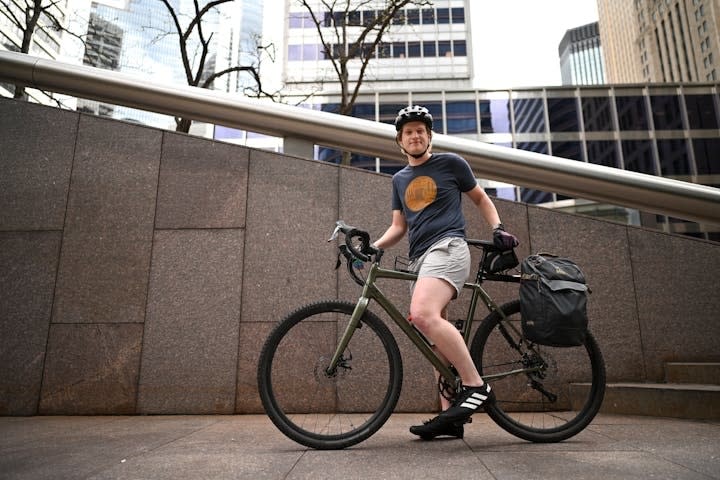Twin Cities suburbs aim to expand bike infrastructure
- Oops!Something went wrong.Please try again later.
Sean Gulbranson would love to bike from his Roseville home to, say, the nearby Target store. But to get there, he'd have to dodge vehicle traffic on a busy, multilane road, with cars moving so fast he'd feel he was risking life and limb.
"Usually if I'm biking in Roseville, I'm trying to get somewhere out of the city," said Gulbranson, who bikes to his job in downtown Minneapolis through St. Paul. Both cities have more protected routes.
He should be getting some safer suburban routes, too, in the coming years. His Ramsey County suburb of 36,000 is working on its first dedicated bike plan, joining a growing number of suburban cities that have plans specifically addressing bike needs, according to the Metropolitan Council.
Roseville, which borders both Minneapolis and St. Paul, has limited bike-dedicated infrastructure. It has 40 miles of paved trails along roads and through parks that serve both bikers and pedestrians, and about 18 miles of striped shoulders.
The city has had a master plan for pathways for decades, but it wasn't bike-specific, said Jennifer Lowry, Roseville city engineer and assistant public works director.
Roseville has obstacles to expanding its pedaling infrastructure: Most major roads there are county- or state-owned. "It's all a partnership conversation, because it's not our right-of-way to dictate," Lowry said.
The city received a state active transportation grant for the bike plan, Lowry said, and is holding public engagement sessions and has an online survey for Roseville cyclists.
Biking the 'burbs
While the debates over bike lanes can be contentious anywhere, suburbs face their own set of challenges to adding them, said Amelia Neptune, the director of the League of American Bicyclists' Bicycle Friendly America program.
Suburbs were generally built for cars — often many lanes of them traveling at high speeds — so making them bike-friendly requires a culture shift, Neptune said.
Cyclists say many suburbs aren't there yet. Take Hwy. 65 in Blaine for example, which longtime cyclist and bike safety instructor Julie Kosbab calls a "death road" that bikers often need to cross to get around. "It's 50 to 60 miles an hour most of the way through, three traffic lanes, left turn lanes, you name it," Kosbab said.
Kosbab said that while Blaine has some bike infrastructure, the emphasis tends to be on recreation, not transportation.
"There's a happy little bike trail that goes to the lake," she said. "But they're not designed to do things like get you to the grocery store."
Six Twin Cities suburbs are listed by the League of American Bicyclists as Bicycle Friendly America communities: Edina, Hopkins, Richfield, St. Louis Park, Stillwater and Woodbury.
Richfield has been adding bike infrastructure in earnest since about 2010, when a Met Council sewer project tore up 76th Street east of Interstate 35, said Richfield City Council Member Sean Hayford Oleary.
"It allowed the community to have, with significant external funding, the opportunity to start from scratch on the street and think what it should entail," he said. The reconstructed street got a separated bike trail that Hayford Oleary said changed the conversation about what Richfield streets should look like.
Nearby, Edina straddles the bike infrastructure challenges of two centuries, said Lou Miranda, a cyclist and member of the city's Planning Commission.
The older part of town was mostly built as a suburb where residents could take the streetcar to their downtown jobs, before major car infrastructure came along. It has less space for bike lanes, but streets are largely on a grid, Miranda said. The newer part of town, largely dating to the '70s and '80s, has large lots and winding streets.
Miranda said he's watched fierce opposition to projects turn to admiration, citing the Nine Mile Creek Regional Trail that connects Edina and nearby cities, including Richfield. "Now it's like the shining jewel of every neighborhood that it goes through," he said.
More money coming soon
Steve Peterson, a senior manager with the Met Council, said surveys show increased demand for cycling infrastructure across the Twin Cities metro area, from suburbs to exurbs to rural areas.
He said he thinks the COVID-19 pandemic shifted thinking: People working from home are looking for trails right outside their doors.
The Met Council plays a major role in distributing funding for bike infrastructure in the region. The regional sales tax passed by the Legislature is expected to add roughly $24 million a year to the $15 million in bike and pedestrian infrastructure federal funds distributed annually by the Met Council's Transportation Advisory Board, Peterson said.
Oftentimes, road or bridge reconstruction is a catalyst for adding bike and pedestrian improvements, Peterson said. For example, one project on the Met Council's draft list for transportation funding this year is a $7 million Ramsey County pitch to reconstruct County Road C in Roseville where it bridges BNSF railroad tracks. The proposal includes a 10-foot sidewalk and a 7-foot bike lane, buffered from cars. The vote to approve it is in July, but Peterson said it's on the board's short list of projects.
"That's going to completely change how people go through that area," Peterson said. "Much safer."


